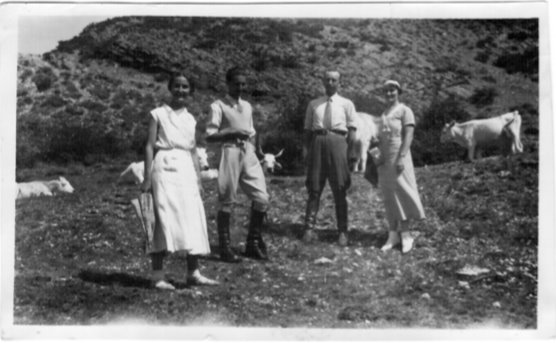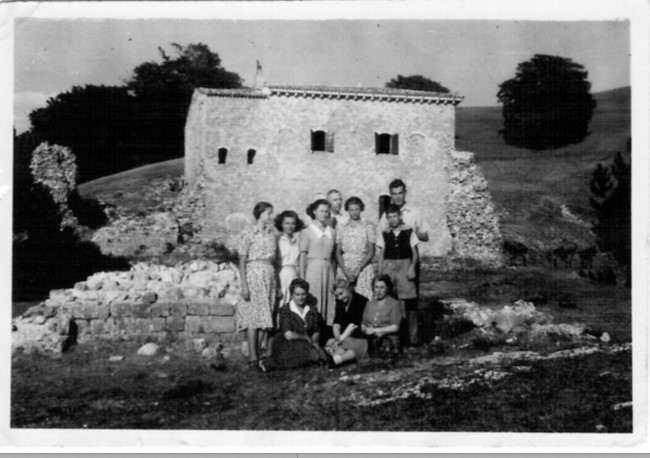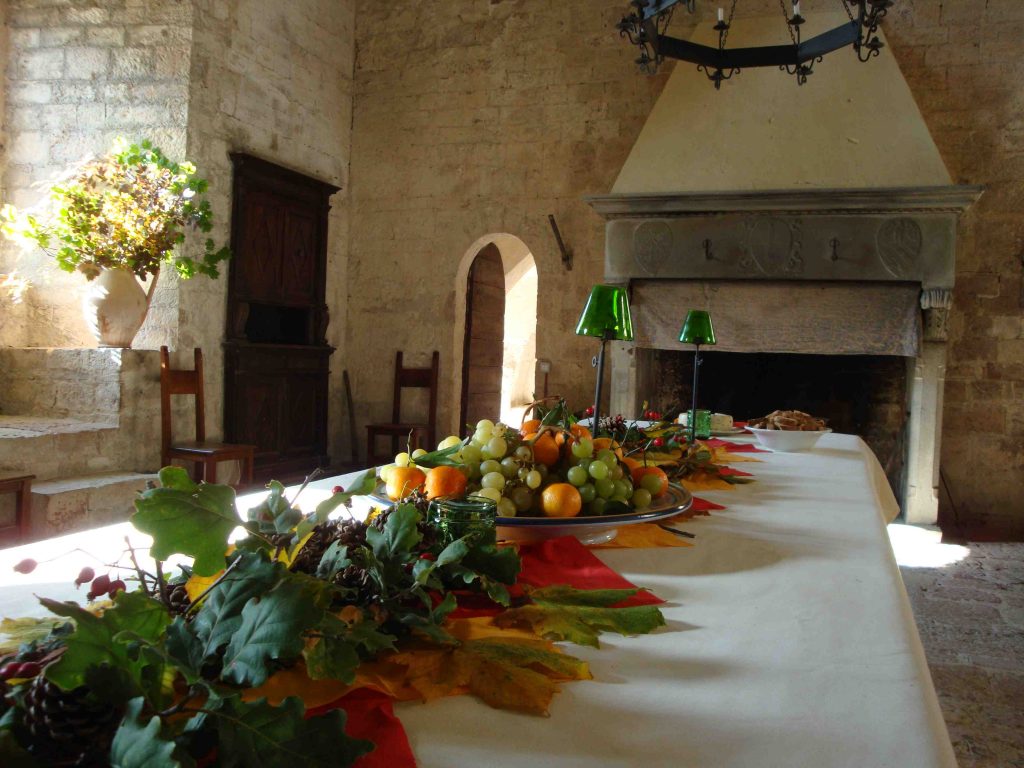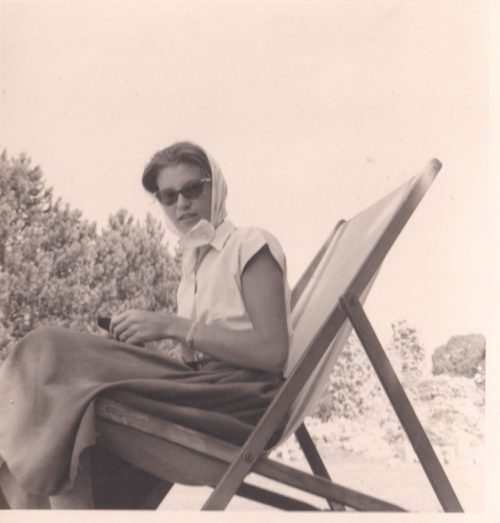Mamma and Papa at the start of their trail

By Francesco Bianchini
Wild Italian mint and thyme, mentuccia and serpillo, are for me the aromas of long summers at San Pietro, my family’s mountain-top retreat. Whole months of my childhood and adolescence were spent there—as were those of my mother and father and of my grandparents, and even my great-grandparents. Old photographs tell the story: each generation lined up in front of the lens, year-after-year, in a variety of geometric combinations. Mothers, fathers, brothers and sisters, groups of just boys or girls, aunts and uncles, cousins – even distant ones – family and friends from far and wide, standing in order of height, like so many strutting organ pipes.

My grandmother and grandfather, great-aunt Maria and their cousin Luigi, San Pietro circa 1927

Family group with my mother (third from right) circa 1948
San Pietro, the remains of a 10th-century Benedictine abbey, straddles the Umbrian Apennines, 900 meters above sea level. My great-grandfather adored such places, far from civilization and practically inaccessible–refuges of an austere and contemplative spirituality. And San Pietro remained inaccessible until the 1970s, reachable only on horseback or on the back of mules, the animals making their way along barely traced tracks, snaking along the side of the mountain, shaded by turkey oaks, chestnut, and beech trees, and along stony stretches on the edge of open ravines.

Aerial view of the Abbey of San Pietro ai Monti
On a hot morning in late July 1960, my father and mother were married in Rome. First cousins, they were basically ordered to spend their honeymoon at San Pietro. This marrying of cousins was the original sin in my family so their marriage was not celebrated in the usual way. Their parents decided to mark the event with only a few family members, and after a hasty reception, the newly married couple left for Umbria and for their exile on the mountain top. At the gate to the property, where the caretaker lived, they left their car and mounted horses to reach the abbey. Rodolfo, my father’s eccentric valet, awaited them, flitting back and forth from the house to the overlook so that he would be the first to spot them as they rode into view.
A few days earlier, while servants were busy preparing the place, there had been an earthquake of some intensity along the Apennine ridge. The caretaker, who was repairing a window at the top of a high ladder, heard the roar swelling from the bowels of the mountain, then saw the wall retracting from his perch, leaving him swinging critically into the void for a few seconds before repositioning him against the wall. The poor maids also got a good scare and ran away at breakneck speed to the valley below. In their panic, they managed to swap the salt for the sugar – so the first meals of my newly-married parents certainly had no claim to haute cuisine.
There are only a few photos of that stay: mother sitting on a deckchair in front of the abbey, reading and surrounded by a flock of sheep; walking along a woodland path in tennis shoes, summer frock, and sunglasses. I try to imagine her happy, savoring the long afternoons, lulled by the chirping of cicadas, dreaming of the future; of a life in the country without pomp and circumstance, rather serene, with lots of children and perhaps – at some point – a better house than the damp, ancient stone “castello” she was destined for in our old family home at Collevalenza.

Mamma on her honeymoon
Italy was at that time in the midst of an economic boom. To beat the summer heat, Italians got behind the wheel of their brand-new cars. Women teased their hair with spray, and the children made a racket on the leatherette seats. In record numbers they clogged the new highways, heading for beaches or mountains – as far from home as possible. But unlike so many members of the new Italian middle class, my family drove only a few miles from the center of Collevalenza to the keeper’s lodge in San Pietro where we’d mount the mules, already saddled and ready to haul us to the top of the mountain for the entire summer.

Me and my younger brother playing in front of the Abbey
There was no electricity or running water at San Pietro and I am reminded, like a series of didactic illustrations of the history of costume, of the arsenal of household goods and kitchen utensils, now extinct, that littered our summer: hand-wound skewers for the fireplace, with the accompanying set of tongs and pokers; copper pots and pans; nickel-plated cutlery; earthenware and blue and white enamel plates; fancy Deruta tableware; the suspended cages for storing cheese and cold cuts out of the reach of mice; oil lamps and candles; archaic coffee pots; antique kettles; and finally, of course, chamber pots by the dozen. In the chapel adjacent to the house—the coolest and most ventilated room—pears, plums, peaches, and tomatoes ripened on wicker trays arranged on the benches in the presence of the Deruta majolica Christ, and the Roman funeral stele of a certain Massellia, entrusted to the deities at the age of twenty-one in the second century BC.

The great fireplace in the Abbey
On the occasion of my parents’ tenth wedding anniversary in 1970, a road was cleared into the mountain that for the first time allowed cars to reach the top. Mama and Papa hosted a grand reception to mark the occasion, and a millstone dated 1830 was transported by tractor and placed on the belvedere in front of the abbey to serve as a base for cocktails and appetizers. If for mom and dad San Pietro had been a kind of “exile on Elba”, for us–even after the inauguration of the road–it was more like Saint Helena. Kilometers of dirt road separated us from the rest of humanity, and an excursion into the civilized world below was no small matter. Once installed on the mountain, we were cut off from the world, and from all the things that drew our attention: friends, radio, television, record players, stores. When any sort of vehicle arrived at San Pietro (we could hear the laboring hum of the engine at several hairpins bends below), we rushed to meet it like the desperate inhabitants of a deserted isle.
The flavor I associate most with San Pietro summers is that of black truffle. Ascenzio, the grounds-keeper guardian, managed the land where truffles could be found. He never revealed the best spots for truffle hunting, but as he passed the abbey with his dogs, Ascenzio would often give us a handful. This rarity was saved for special occasions, one of which was the mid-August lunch, when Ascenzio’s wife roasted lamb and potatoes. There were also chops and sausages barbequed with serpillo in the immense Renaissance fireplace; rice salads, grilled vegetables seasoned with oil, chopped garlic, and mint; tarts and fruit salads. Before we gathered at the table for lunch, we children were expected to circulate among the guests with trays of toasted bread smeared with truffle sauce. We made sure that everyone had helped themselves at least a few times before we quarreled over what was left.







